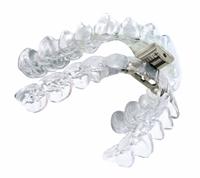Ira Shapira
 While sleep medicine still considers CPAP/BiPAP to be the gold standard of treatment for sleep apnea, low compliance rates (23-45% based on several studies) have always been a problem. The alternatives in treatment are lifestyle changes including weight loss and positional training, surgery and dental appliances. The advantages of surgical interventions have been that they require no patient compliance after initial healing, though surgical morbidity is often very high. Dental appliances on the other hand have high patient compliance and minimal morbidity. The majority of patients continues use and prefers them to CPAP/BiPAP.
While sleep medicine still considers CPAP/BiPAP to be the gold standard of treatment for sleep apnea, low compliance rates (23-45% based on several studies) have always been a problem. The alternatives in treatment are lifestyle changes including weight loss and positional training, surgery and dental appliances. The advantages of surgical interventions have been that they require no patient compliance after initial healing, though surgical morbidity is often very high. Dental appliances on the other hand have high patient compliance and minimal morbidity. The majority of patients continues use and prefers them to CPAP/BiPAP.
A recent study in the journal Chest (chest. 220:121:739-746) showed a higher success rate for dental sleep apnea appliances when compared to Uvulopalatophayngoplasty (UP3) on mild to moderate apnea patients who were followed up to four years. The success rate in the dental appliance group was 81% compared to 53% in the UP3 group. Success was defined as at least 50% reduction in the apnea index. A more impressive figure was normalization or “cure” with 63% of the dental appliance patients falling in this group with only 33% of UP3 patients falling in this group at the four-year follow-up. The definition of a cure was an apnea index less than 5 or an apnea/hypopnea index of less than 10. The dental appliance had 62% compliance rate (much higher than CPAP) with minimal adverse side effects. In the surgical group, 8% reported pronounced nasopharyngeal regurgitation of fluid (food and fluid entering nasal cavity) and 10% had significant swallowing problems.
A previous article in Chest reported a 98% success rate with the TAP appliance in treating snoring and high success in treating moderate to severe apnea. The TAP appliance can be adjusted while the patient is sleeping and this adjustability serves as a volume control for the patient’s significant other.
It is vital that patients being treated with a dental appliance or surgery have diagnostic polysomnography to evaluate efficacy for the treatment and for appliance titration. With proper follow-up, appliance therapy may one day be the gold standard of treatment if compliance is considered into the equation.
